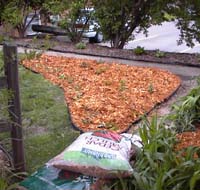 | |
This smothered corner of lawn was recently planted with prairie seedlings. |
You can literally lop off a corner and create a planting bed that will complement—not compete with—your lawn. Step 1. Choose one corner of your lawn (your least favorite, the least healthy, the one you see most often) to cut off. Step 2. Lay a garden hose or rope on the ground to represent your new planting bed's edge, and adjust it until you decide exactly where you want it. The edge can be curved or straight. You may find it easier to decide its shape if you know what edging material you plan to use. Step 3. Install edging either all the way around the corner or just along the edge that it shares with the lawn. If desired, add a mowing strip along the lawn-facing edge. Step 4. Smother the lawn in your new corner garden. Step 5. While you wait for the grass to die over a season or two, use the time to design your new corner garden. Consider these factors:
- You may want to design your new garden area to fit well with the rest of your landscape. Try these strategies to create a mood and style consistent with other areas:
- Edge with a material that shows up elsewhere in the garden.
- Repeat a few key plants that occur in other areas.
- Echo major colors.
- Use colors that complement (rather than clashing with) other colors in the landscape.
- Physically connect the new area to the old with an arch over a walkway or a stepping-stone path through the lawn to another garden area.
- On the other hand, you may want to establish a garden that departs drastically from the rest of the landscape and has its own theme, a specialty garden for plants you've always wanted to grow that wouldn't fit into other areas. A few ideas:
- herb garden (read LessLawn's comparative review of 10 herb garden books)
- cutting garden (for flowers)
- conifer garden
- rock garden
For the least maintenance and the healthiest plants, choose plants that fit the microclimate of your corner. Match them to its soil moisture, winter climate, soil acidity, and sun exposure. Note that these characteristics of your site will change throughout the year. Note also that plants from the same native ecosystem will likely "look right" together as well as sharing the same site preferences, so modeling your garden after a regional ecosystem can be a useful strategy.
Your design will only be preserved if the plants can coexist happily with each other. In addition to all having similar preferences in microclimate (see above), they should also have complementary growth habits. If you've grown the plants, you've probably observed their habits well enough to predict how they'll mingle. If not, other gardeners may be able to help (find books that are heavy on individual plant descriptions, such as Lauren Springer's The Undaunted Garden, Christopher Lloyd's The Well-Tempered Garden, and Mirabel Osler's A Gentle Plea for Chaos, or consult your favorite gardeners in person and in print).
Meanwhile, here are a few general pointers about growth habits:
- Spreaders and clumpers are best mixed when they have different heights or will be allowed to intertwine freely with each other.
- Taller plants may sprawl as the season progresses and shade out sun-loving shorter ones.
- Thick, leafy plants may crowd out those with less lush or sturdy foliage.
- Plants with airy growth habits can often weave between and around the more rigid ones to create a living bouquet.
- You may want to plan for year-round structure and interest, especially if your corner garden is highly visible from the house or located along a frequently traveled route. Think about the parts of the plants that will stand in winter, and include some evergreen foliage, interesting bark, or stalks with prominent seedheads that you can leave uncut until early spring.
- Most importantly, choose plants you love, because YOU are their chief caretaker and admirer.
Step 6. When the grass is sufficiently smothered, plant through the mulch and newspapers. Step 7. Water plants well when planting and for the next several weeks to ensure that they establish with minimum disturbance. Step 8. Mow less and enjoy your garden more! (Later you may decide to cut more corners...)
|